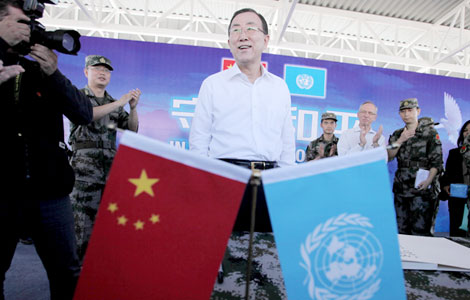Joint action needed for clean air
Updated: 2013-06-01 01:35
(China Daily)
|
||||||||
The treatment of Beijing's air pollution needs the cooperation of neighboring areas, experts said on Friday when the city reported a modest improvement in its air quality in 2012.
The report, published by the Beijing Municipal Environmental Protection Bureau, showed that the sulfur dioxide, nitrogen dioxide and inhalable particle density in the air has decreased 1.5 percent, 5.5 percent and 4.4 percent, respectively, from the previous year.
The emission load of sulfur dioxide, nitric oxide, and ammonia nitrogen has decreased 4.12 percent, 5.75 percent and 3.95 percent compared with 2011, according to the report.
Though Beijing started to monitor PM2.5, or particulate matter smaller than 2.5 microns, and release updates since last year, the report did not include the figures for PM2.5 because facilities and methods for measuring PM2.5 are not finalized, said Zhang Dawei, who heads the city's environmental protection monitoring center.
"We have made a great effort in the past several years to improve the air quality, but it still lags behind the standard and people's expectations," said Yu Jianhua, chief of the atmospheric administration office of the Beijing Municipal Environmental Protection Bureau.
"It's a complicated process to treat the air and it takes a long time. What we can do is insist on trying our best to make an improvement every year," Yu added.
To treat the air pollution, the capital has reduced coal use by 700,000 metric tons and also weeded out 377,000 old vehicles in 2012.
While the improvement is thought to lag behind people's expectations, experts spoke highly of it.
"Air pollution is a complicated problem resulting from both economic and meteorological factors. It has been a great success reduce concentration and emissions so much," said Zhang Yunhui, an associate professor at the Public Health School of Fudan University in Shanghai.
"The government of Beijing has made great efforts," said Ma Jun, director of the Institute of Public and Environmental Affairs. "They have made great improvements in emission reduction."
But Beijing's effort alone is not enough, Ma said.
Tianjin municipality and Hebei province consume 70 million tons and 200 million tons of coal every year, respectively. Pollutants from Tianjin and Hebei can be brought to Beijing by wind and be kept there because of Beijing's geographical conditions.
"The final treatment of air pollution needs the cooperation of Beijing with neighboring provinces," Ma added.

 Michelle lays roses at site along Berlin Wall
Michelle lays roses at site along Berlin Wall
 Historic space lecture in Tiangong-1 commences
Historic space lecture in Tiangong-1 commences
 'Sopranos' Star James Gandolfini dead at 51
'Sopranos' Star James Gandolfini dead at 51
 UN: Number of refugees hits 18-year high
UN: Number of refugees hits 18-year high
 Slide: Jet exercises from aircraft carrier
Slide: Jet exercises from aircraft carrier
 Talks establish fishery hotline
Talks establish fishery hotline
 Foreign buyers eye Chinese drones
Foreign buyers eye Chinese drones
 UN chief hails China's peacekeepers
UN chief hails China's peacekeepers
Most Viewed
Editor's Picks

|

|

|

|

|

|
Today's Top News
Shenzhou X astronaut gives lecture today
US told to reassess duties on Chinese paper
Chinese seek greater share of satellite market
Russia rejects Obama's nuke cut proposal
US immigration bill sees Senate breakthrough
Brazilian cities revoke fare hikes
Moody's warns on China's local govt debt
Air quality in major cities drops in May
US Weekly

|

|







